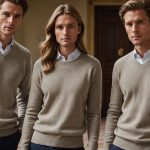Understanding Eco-Friendly Materials
Eco-friendly materials are pivotal in the production of winter coats, representing a shift towards more sustainable and ethical fashion. These materials are designed to have a reduced environmental impact. They use less energy, water, and raw materials, reducing the fashion industry’s overall carbon footprint.
Sustainable fabrics frequently found in winter coats include organic cotton, Tencel, and recycled polyester. Organic cotton is grown without harmful pesticides, preserving soil health and water systems. Tencel is produced from sustainably sourced wood pulp, renowned for its softness and biodegradability. Recycled polyester utilises post-consumer plastic, cutting down on landfill waste and decreasing reliance on petroleum-based fibres.
Also read : Master Your Winter Style: Pro Tips for Perfect Layering and Texture Mixes
Ethical sourcing ensures the materials are not only environmentally friendly but also consider the welfare of workers involved in their production. This includes fair wages, safe working conditions, and minimal environmental disruption. Brands committed to ethical sourcing often seek certifications from bodies like the Global Organic Textile Standard (GOTS) or Fair Trade, which assure compliance with high standards for both environmental and social criteria.
Understanding these aspects is crucial for consumers keen on making informed choices that reflect their values concerning sustainability and ethical responsibility in the fashion industry.
This might interest you : Easy hacks to revamp your summer wardrobe into a gorgeous fall fashion ensemble on a budget
Top Brands for Eco-Friendly Winter Coats
Exploring sustainable winter coat brands reveals an enticing selection of options for the eco-conscious consumer. These brands prioritise environmentally friendly practices and materials, ensuring their products align with eco-conscious values.
Overview of Leading Brands
Several eco-conscious fashion brands are noteworthy for their commitment to sustainability. In the UK, labels like Patagonia, Boden, and Finisterre have become synonymous with environmentally responsible winter wear. They skillfully combine style with ethics, using sustainable fabrics such as organic cotton or recycled polyester to craft functional and fashionable winter coats.
Brand-Specific Features
Each brand has unique characteristics that contribute to their sustainability credentials. Patagonia is famous for its robust environmental activism and Fair Trade Certification. Boden focuses on ethical sourcing and classic British style, while Finisterre is noted for innovative use of recycled materials and ocean-friendly practices.
Comparisons of Brand Sustainability Practices
When comparing brand sustainability practices, consider factors such as the materials used, the production process, and social responsibility. Patagonia’s comprehensive environmental stewardship, for instance, sets a high bar, whereas Boden’s dedication to fair trade and worker welfare rounds out a holistic ethical approach.
Style Trends in Eco-Friendly Winter Coats
Navigating the world of eco-friendly fashion trends reveals an enticing tapestry of design innovation and functionality. This season, sustainable winter coat styles combine practicality with chic form, providing warmth without compromising on eco-conscious principles.
Functional design meets fashion in these sustainable designs, where lightweight insulation and durable materials ensure comfort even in harsh climates. Key elements such as detachable hoods, adjustable cuffs, and multi-pocket designs reflect an intelligent use of resources, enhancing versatility and enduring style.
Colour plays a pivotal role, with popular colours reflecting nature-inspired palettes such as earthy greens, deep ocean blues, and warm autumnal shades. Patterns, too, are gaining popularity, including subtle herringbone or classic plaids, offering a timeless appeal.
Fashionable winter outfits can be effortlessly elevated by pairing coats with accessories such as recycled wool scarves or organic cotton beanies. Brands creatively incorporate recycled or sustainably sourced elements into designs, proving that eco-friendly attire doesn’t forfeit style. Consumers can tap into these trends to express individuality while making environmentally responsible choices. By prioritising these eco-friendly fashion trends, shoppers can embrace the colder months with confidence and a clear conscience.
Sizing Information and Fit
Ensuring the right winter coat sizing is crucial, particularly when selecting an eco-friendly option. Proper fit enhances comfort and optimises the coat’s insulating properties, critical during colder months. It’s important to understand each brand’s fit guide as eco-friendly brands may have unique sizing due to the specific materials used, contributing to a different feel compared to conventional options.
Importance of Proper Sizing
Proper sizing guarantees functionality by ensuring the coat can be layered over clothing while maintaining freedom of movement. A well-fitting coat will perform better against harsh elements, providing the warmth and protection needed during winter.
Sizing Charts for Eco-Friendly Brands
Many eco-friendly brands offer detailed sizing charts on their websites, which are invaluable tools. They help consumers choose the correct size by providing exact measurements tailored for different body types. These charts usually offer guidance based on bust, waist, and hip measurements.
Tips for Finding Your Perfect Fit
To find your perfect fit, consider trying coats over the layers you typically wear. Additionally, consult the brand-specific fit guide for insights into how their coats are designed to fit. Remember, although eco-friendly coats may feel different, this difference often adds to their environmental and ethical appeal.
Where to Purchase Eco-Friendly Winter Coats
Exploring options to buy eco-friendly coats can guide you toward numerous sustainable fashion retailers. These platforms not only offer a variety of eco-conscious choices but also assure that your purchase aligns with environmental values. For online shopping aficionados, websites specifically dedicated to sustainable fashion are invaluable resources.
Many consumers in the UK prefer UK online shopping platforms, such as ASOS and Net-a-Porter, for their convenient access to a plethora of eco-friendly options. These outlets provide detailed information about the materials and ethical sourcing behind the coats, offering transparency that helps in making informed decisions.
Meanwhile, it’s equally rewarding to explore local UK retailers that focus on sustainability. Stores like The Natural Store and Thought Clothing specialise in eco-friendly winter wear, ensuring both quality and ethical sourcing.
Purchasing directly from eco-conscious brands has its perks, including supporting their green initiatives and sometimes benefiting from exclusive offers. This direct approach often yields insights into the sustainable production practices employed by the brands. Whether online or from local outlets, the selections cater to the green values avid shoppers espouse, creating a win-win for style and environmental stewardship.
Price Ranges for Eco-Friendly Winter Coats
Navigating the world of eco-friendly coat pricing reveals a landscape catering to diverse budgets, allowing more consumers to access sustainable fashion without breaking the bank. Understanding the cost of sustainable winter wear involves recognising the factors that contribute to price differences among various brands and models.
Overview of Pricing Variability
Pricing for eco-friendly winter coats ranges from affordable to high-end, often reflecting the quality of materials and ethical production processes. High-quality, sustainably sourced materials such as organic cotton or Tencel may increase manufacturing costs, translating to higher retail prices.
High-End vs. Affordable Eco-Friendly Options
While high-end sustainable brands offer premium designs featuring luxurious materials and cutting-edge technology, affordable options do not compromise on being eco-conscious. Brands strive to make eco-friendly fashion accessible, providing budget-friendly lines that still uphold environmental and ethical standards.
Understanding Value in Sustainable Fashion
The value in sustainable fashion extends beyond the initial purchase price. Investing in higher-priced, durable coats often results in long-term savings, as these pieces tend to last longer and maintain their functionality and style over time. Buyers can confidently choose an eco-friendly wardrobe, knowing they support a cleaner fashion industry while enjoying a return on investment.
Care Tips for Eco-Friendly Winter Coats
Caring for your eco-friendly winter coat is essential to prolong its lifespan and maintain its quality. Using sustainable clothing care methods ensures your investment supports the environment in the long run.
Best Practices for Washing and Maintaining Eco-Friendly Fabrics
Washing your coat less frequently helps in preserving its materials. When needed, opting for cold water and eco-friendly detergents greatly benefits your eco-friendly garment care routine. It reduces energy consumption and minimizes damage to delicate sustainable fabrics. It’s advisable to spot clean small stains to avoid unnecessary washes.
Prolonging the Life of Your Winter Coat
Consistent maintenance, like hanging your coat properly and storing it in a cool, dry place, is crucial. For outerwear with zippers, ensure they are aligned before storing to prevent damage. For coats with down or recyclable polyester filling, fluffing them post-wash keeps them insulated and comfortable.
Importance of Following Care Labels and Eco-Friendly Products
Always adhere to the care labels to ensure you use the right washing temperature and method. This prevents fabric deterioration and maintains the coat’s structure. Consider eco-friendly care products, which are gentle on the fabric and environment. By following these winter coat maintenance tips, your coat remains a staple in your sustainable wardrobe for years to come.
Environmental Impact Assessments
Understanding the environmental footprint of winter coats is essential to making informed decisions. By evaluating eco-friendly production practices, consumers can better appreciate the sustainability of their clothing choices.
Understanding the Life Cycle of Winter Coats
The life cycle of a winter coat involves stages that include material sourcing, manufacturing, distribution, use, and disposal. Eco-friendly production practices at each stage can significantly reduce a coat’s overall sustainability impact. For example, choosing sustainable fabrics and efficient manufacturing processes minimizes waste and energy consumption.
Comparative Analysis of Different Materials
When assessing eco-friendly materials, it’s crucial to compare their environmental footprint. Organic cotton, for instance, uses fewer pesticides and fertilizers than conventional cotton, thus lowering its impact. Similarly, recycled polyester reduces reliance on raw resources and cuts down on landfill waste.
Measuring the Overall Environmental Impact of Fashion Choices
Tools such as Life Cycle Assessment (LCA) allow for a comprehensive evaluation of the sustainability impact of fashion items. These assessments take into account factors such as carbon emissions, water use, and waste. By understanding these elements, consumers can select winter coats that align with their environmental values, thereby reducing their personal fashion footprint.
Consumer Reviews and Testimonials
In the realm of eco-friendly coat reviews, customer feedback plays a critical role in guiding potential buyers. Consumer feedback frequently highlights the durability and comfort of sustainable winter coats, illustrating the effectiveness of eco-friendly materials. Many users praise coats made from sustainable fabrics like organic cotton and recycled polyester, noting their warmth retention and softness.
Reviews often spotlight standout products within the sustainable coat market, emphasizing brands that successfully blend style with sustainability. For instance, a popular coat might garner attention for its innovative use of biodegradable materials, alongside stylish design and effective functionality in harsh weather conditions.
Winter coat testimonials offer valuable insights into the environmental impact of these products. Customers often share positive remarks regarding brands with transparent ethical sourcing practices. Ethical considerations, such as fair trade and environmentally responsible production, frequently contribute to high satisfaction levels among eco-conscious consumers.
The overall satisfaction with eco-friendly coats often hinges on a balance between performance and sustainability claims. By examining diverse reviews and testimonials, shoppers can discern which brands and styles truly incorporate sustainable practices, ensuring their purchase aligns with their environmental values while enjoying a high-performing winter coat.










